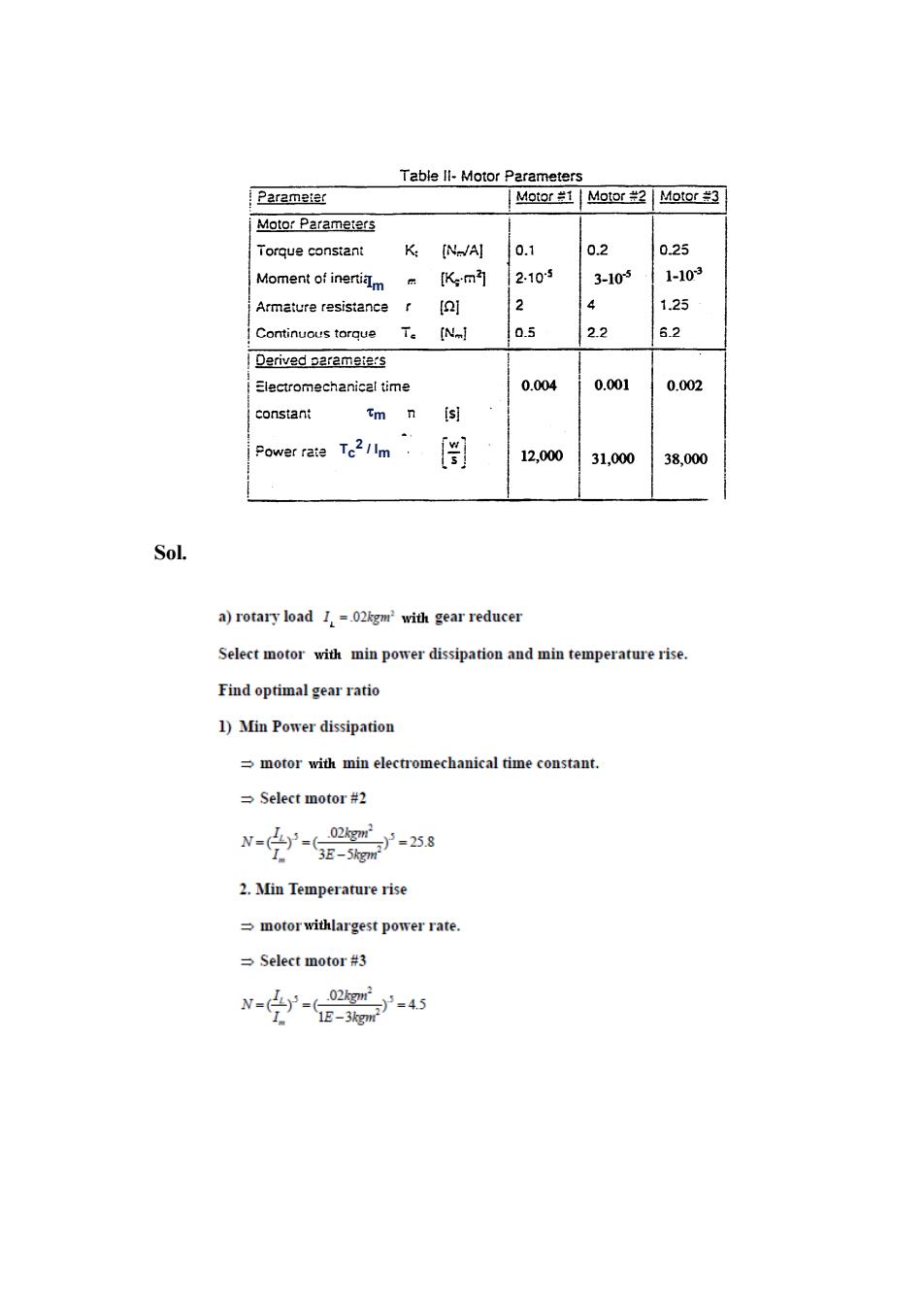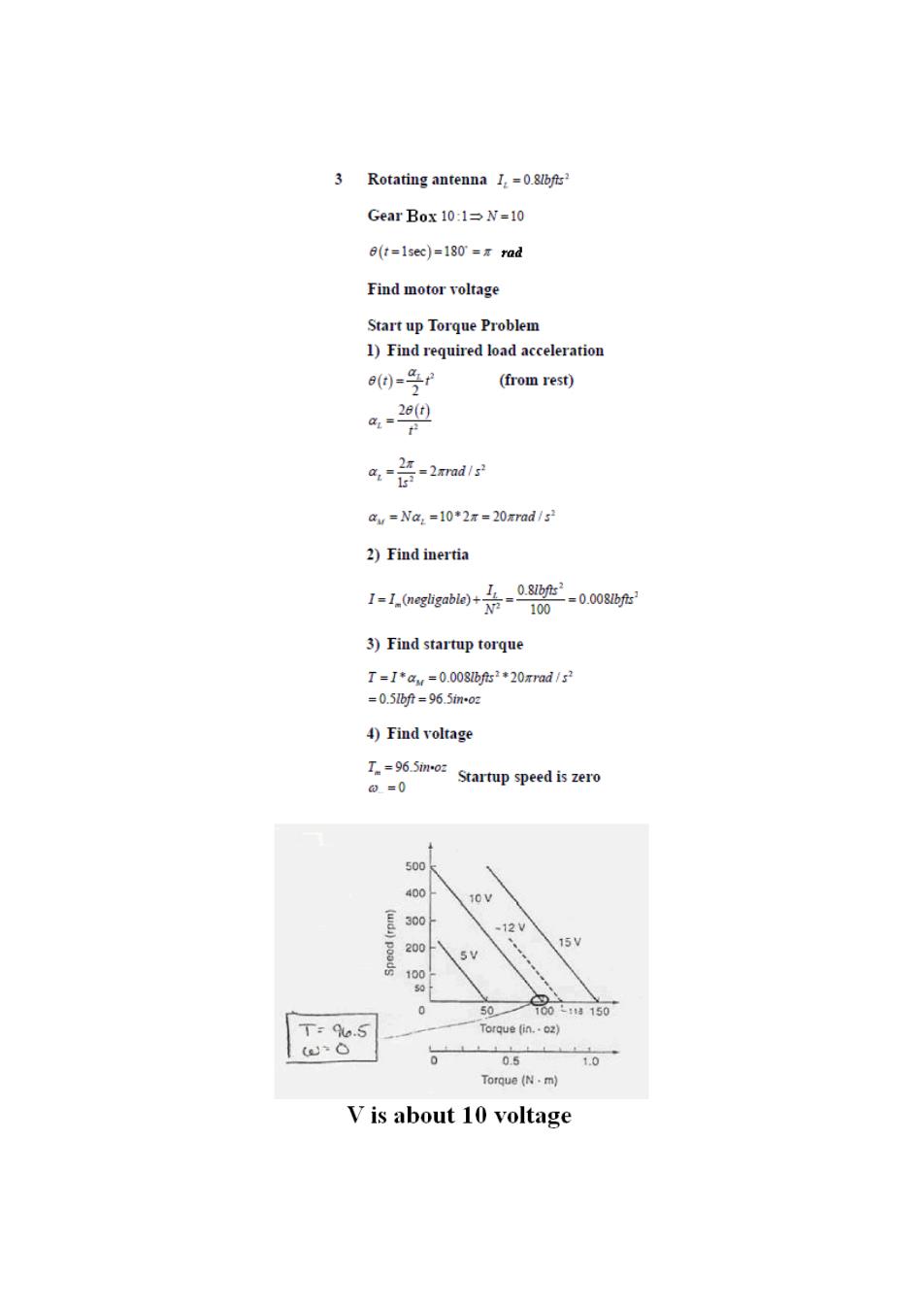
Motor Homework Solutions Problem 1: Statement: Which type(s)of electric motor would you specify To drive a load with large inertia. b. To minimize variation of speed with load variation. To maintain accurate constant speed regardless of load variations. Solution: See Mathcad file P0216. a Motors with high starting torque are suited to drive large inertia loads.Those with this characteristic series-wound,compound-wound,and shunt-wound DC motors,and capacitor-start AC motors. b. Motors with flat torque-speed curves(in the operating range)will minimize variation of speed with load variation.Those with this characteristic include shunt-wound DC motors,and synchronous and capacitor-start AC motors. Speed-controlled DC motors will maintain accurate constant speed regardless of load variations. Problem 2: Refer to the AC motor performance curve in the following figure. a)What type of motor is the curve likely to represent? b)If the motor is a six-pole type,rated at 0.75 hp,how much torque can it exert at the rated load? c)How much torque can the motor develop to start a load? d What is the breakdown torque for the motor? 100 80 60 40 20 0 0 100 200 300 400 Torque (percentage of full-load torque)
Motor Homework Solutions Problem 1: Problem 2: Refer to the AC motor performance curve in the following figure. a) What type of motor is the curve likely to represent? b) If the motor is a six-pole type, rated at 0.75 hp, how much torque can it exert at the rated load? c) How much torque can the motor develop to start a load? d) What is the breakdown torque for the motor?

Sol. a) Single phase,split-phase AC motor b) 6-pole No-load Speed 1200 rpm (Norton Table 2-6) Full-load Speed 1140 rpm T= 63000H n T=63000H_63000×0.7 1140 =414bim n c Tsar =1.5Trated Tn =1.5Trated =1.5x41.4lb.in=62.2lb-in d)Tbreak =345%Trared Tbreak=345%T,med=345%×41.4=142.81b.in Problem 3: Three examples of motors,with their parameters are listed in the Table below.For each case pick the best motor. a)A rotary load with a moment of inertia of 0.02 Kg m2 is driven by a gear reducer. Select the motor that produces the minimum power dissipation and the motor that results in minimum temperature rise.Find the optimal gear ratio in either case. b)A mass of M=0.75 Kg must be driven by a pulley.Select the motor that can drive it under minimum temperature rise and find the optimal radius size
Sol. a) Single phase, split-phase AC motor b) 6-pole No-load Speed 1200 rpm (Norton Table 2-6) Full-load Speed 1140 rpm c) d) T T break rated 345% Problem 3: Three examples of motors, with their parameters are listed in the Table below. For each case pick the best motor. a) A rotary load with a moment of inertia of 0.02 Kg m2 is driven by a gear reducer. Select the motor that produces the minimum power dissipation and the motor that results in minimum temperature rise. Find the optimal gear ratio in either case. b) A mass of M = 0.75 Kg must be driven by a pulley. Select the motor that can drive it under minimum temperature rise and find the optima1 radius size. 63000H T n 63000 63000 0.75 41.4 1140 H T lb in n 1.5 T T start rated 1.5 1.5 41.4 62.2 T T lb in lb in start rated 345% 345% 41.4 142.8 T T lb in break rated

Table ll-Motor Parameters Parameter Motor #1 Motor #2 Motor #3 Motor Parameters Torque constant [N-/A] 0.1 0.2 0.25 Moment of inertiam Km的 2105 3-105 1-103 Armature resistance r [2] 3 4 1.25 Continuous torque Te [NmI 0.5 22 6.2 Derived p2r2me色rs Electromechanical time 0.004 0.001 0.002 constant tm n s Power rate Tc2/lm [) 12,000 31,000 38,000 SoL a)rotary load I =.02kgm'with gear reducer Select motor with min power dissipation and min temperature rise. Find optimal gear ratio 1)Min Power dissipation motor with min electromechanical time constant. Select motor #2 =y= 02gm2 -25.8 3E-5kgm 2.Min Temperature rise motor withlargest power rate. Select motor #3 N---45 1E-3kgm
Sol. m Tc 2 / Im m

b)mass M=.75kg Select motor with min temperature rise and find optimal radius size. Min temperature rise motor with largest power rate. Select motor #3 Optimal pulley radius inertia matching 12=mr2=J ” .75g =.037m -3.7cm Problem 4: A rotating antenna has a moment of inertia(I)of 0.8 Ib ft s2.It is driven through a 10: 1 gearbox by a DC motor (motor runs faster).The antenna must be able to rotate 180 degrees from rest in 1 s.The motor characteristics are given below.Find the motor voltage required. 500 400 10v 300 12V 200 15V 5V 100 0 50 100L118150 Torque (in.·oz) 0 0.5 1.0 Torque(N·m)
Problem 4: A rotating antenna has a moment of inertia (I) of 0.8 lb ft s2 . It is driven through a 10: 1 gearbox by a DC motor (motor runs faster). The antenna must be able to rotate 180 degrees from rest in 1 s. The motor characteristics are given below. Find the motor voltage required

3 Rotating antenna I.=0.8lbfis? Gear Box 10:1>N=10 6(t=1sec)=180=元rad Find motor voltage Start up Torque Problem 1)Find required load acceleration 0-受f (from rest) 26(t a= 2 =2xad/s ,=F au=Na:=10*2x=20xrad/s 2)Find inertia I=1_(negligable)+- _08bt-0.08bt2 100 3)Find startup torque T=I*a=0.008lbfis**20xrad/s =0.5bf=965moz 4)Find voltage T.=96.Sim-0z 0=0 Startup speed is zero 500 400 10V 300 -12V 200 15V 5V 100 50 100150 T=96.5 Torque (in.·oz) w- 0.5 1.0 Torque(N·m) V is about 10 voltage